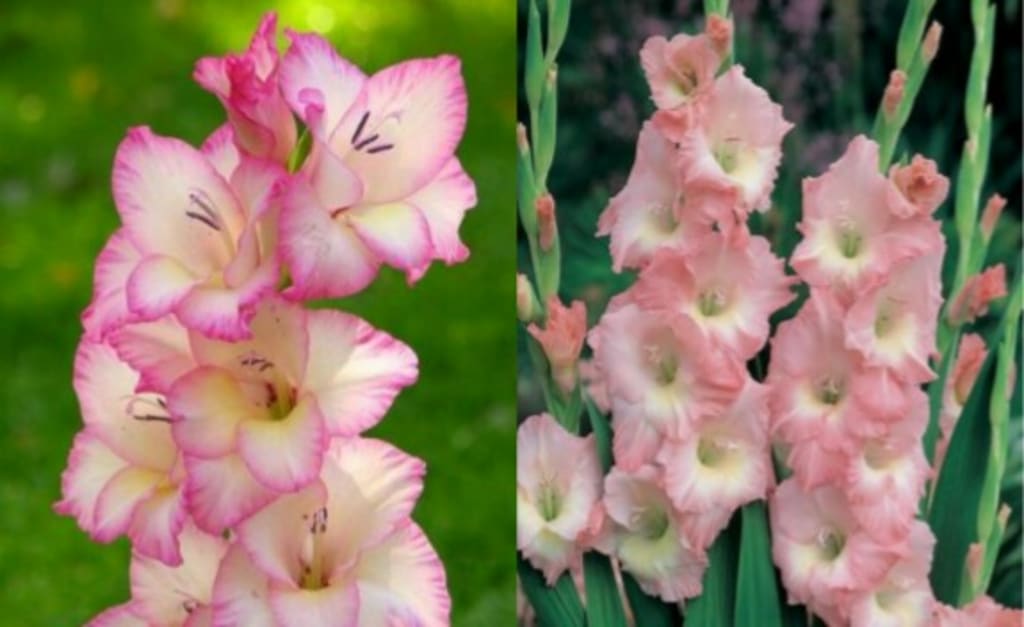How to grow Gladiolus and it’s impotance?
Gardening,grow flowers,gladiolus

Introduction
• Gladiolus hybrids
• Most common hybrids Gladiolus grandiflorus
• Derived from Latin word ‘Gladiolus’ (Sword).
• ‘Sword Lily’
• Member of family ‘Iridaceae’
• Genus Gladiolus contains approx. 200 species.
• Origin South Africa
• Geo phytes Plants grown from underground modified stems
o Bulbs, corms, tubers, rhizomes, stolons etc.
Importance

• 2nd most popular flower in Pakistan (after roses).
• Included in top ten cut flowers of the world.
• Can be grown as:
o Cut flower
o Bedding plant/ border plant
o Potted
Soil and climate
• All types of soil (with good structure, texture, and
drainage) are Okay.
• Sandy loam soils are preferable.
• If heavy soils:
o apply OM
o Grow on raised beds or ridges
• If lighter soils:
o Use mulching
• Optimum pH 6-7
• Gladiolus can be grown in wide
range of climatic conditions.
• In Pakistan, can be produced year round.
• Light is most important for
flowering.
• Optimum temperature 10-25°C
o Below 10°C, growth is delayed.
o Can not tolerate freezing or over 30°C.
o Above 30C, shorter spikes with
smaller floret diameter are
produced.
o Also have shorter vase life when grown above 30C
• Humidity should be high if temperature goes beyond 30°C.
Light

• Important to initiate flowering.
• If grown in winter (low light):
o Use bigger corm size
o Grow less light-sensitive cultivars
o Use less planting density
o Avoid shady areas.
o Use good rooting substrate
o Do not grow in greenhouse with dirty glass or sheet.
Propagation method
• propagation method
o Division of corms
• Corms are underground,
compressed, round stems which
have buds to grow into new plants.
• Propagation Time
o After harvesting flowers and yellowing/drying of leaves.

Corm Selection
• Corm size selection depends on:
o Growing conditions (light and temp.)
o Planting time
• Larger corms would
produce:
o Taller and firmer plants with heavy spikes
o More uniform production
o Early flowering
o More than one stems per corm.
• Smaller corms would:
o Delay production
o .Small spikes and floret size.
Planting
• Planting methods
o Ridges (2-2.5 ft wide) (if flood irrigation)
o Beds (if drip irrigation)
• Planting Time
o Late August to November (Plains)
o March-April (Hilly areas)
• Plant density
o Greatly affect flower production
o Approx. 60,000 corms/acre
o P-P 3-4” (8-10 cm)
o R-R 2.0-2.5 ft (60-75 cm)
o Planting depth 8-10 cm
• At planting, soil should be moist, but not wet.
• Treat corms with fungicide before planting.
Fertilization
• Fertilization depends on:
o Soil fertility
o Soil pH
o Precipitation
o Plant density
o Plant growth stage
• Avoid use of FYM.
• Fertilization may be
done at:
o Time of soil preparation
o Delayed until emergence
• Do not use heavy
fertilization on gladiolus.

Irrigation
• Require plenty of water
• Irrigation time depends on:
o Climatic conditions
o Crop growth stage
• Drip irrigation is best
• Do not use sprinkler
Irrigation
• Use good quality water
• Deficiency of water may lead
to poor flower development and shorter spikes.
• Apply irrigation at:
o Planting
o Initiation of spikes
o Floret development.
• Covering up the corms and the root
system to support the stems.
• Done when soil is heavy and deep planting is not possible.
• Minimize lodging
• Maximize corm and
development.
• Eradicate weeds.
• Practiced when plants reach 2-3 leaf
stage (at 20-30 cm plant height).
VITAMIN D
The biologically active form of this vitamin is 1,25dihydroxy vitamin D3 (calcitriol) called as cholecalciferol
• Calcitriol functions primarily to regulate calcium and phosphorous homeostasis
• Active calcitriol is derived from ergosterol (produced in plants) and from 7-dehydrocholesterol (produced in the skin)
• Ergocalciferol (vitamin D2) is formed by UV irradiation of ergosterol
FUNCTIONS
• Keep gums and muscles in good shape & help body to resist infection
• It inhibits proliferation and stimulates the differentiation of cells
• It may enhance innate immunity and inhibit the development of autoimmunity (A condition in which the body's immune system reacts against its own tissues)
• Insufficient vitamin D levels may have an adverse effect on insulin secretion
• Adequate vitamin D levels may decrease the risk of high blood pressure Innate immune system
• The innate immune system, also known as the non-specific immune system or in-born immunity system, is an important subsystem of the overall immune system that comprises the cells and mechanisms that defend the host from infection by other organisms. The cells of the innate system recognize and respond to pathogens in a generic way, but, unlike the adaptive immune system, the system does not provide long-lasting immunity to the host. Innate immune systems provide immediate defense against infection, and are found in all classes of plant and animal life. The innate immune system is an evolutionary older defense strategy, and is the dominant immune system found in plants, fungi, insects, and primitive multicellular organisms.
• The major functions of the vertebrate innate immune system include:
• Recruiting immune cells to sites of infection, through the production of chemical factors, including specialized chemical mediators, called cytokines
• Activation of the complement cascade to identify bacteria, activate cells, and promote clearance of antibody complexes or dead cells
• Identification and removal of foreign substances present in organs, tissues, blood and lymph, by specialized white blood cells
• Activation of the adaptive immune system through a process known as antigen presentation
• Acting as a physical and chemical barrier to infectious agents.
SOURCES
Sunlight, milk and other dairy products fortified with vitamin D, fish, egg yolks
DEFICIENCY
In vitamin D deficiency, calcium absorption cannot be increased enough to satisfy the body’s calcium needs
• Severe vitamin D deficiency has serious consequences for bone health and increase the risk of osteoporosis (a medical condition in which the bones become brittle and fragile from loss of tissue, typically as a result of hormonal changes) and other health problems
• In infants and children, severe vitamin D deficiency results in the failure of bone to mineralize (rickets)
• Weight-bearing limbs (arms and legs) become bowed & in infants may result in delayed closure of the fontanels (soft spots) in the skull
• In adults bone mineral is progressively lost, resulting in bone pain and osteomalacia
• Deficiency causes muscle weakness and pain in children and adults






Comments
There are no comments for this story
Be the first to respond and start the conversation.